Historical Society updated on Glenwood Cemetery’s touchstones to the past
Administrator | Sep 26, 2018 | Comments 0
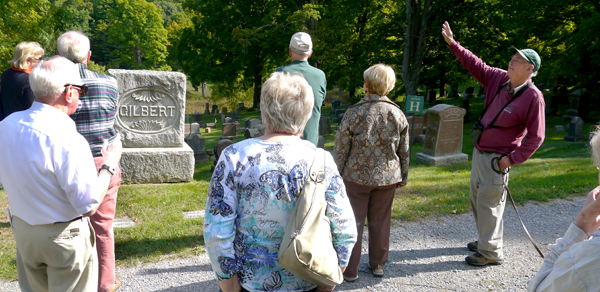
County naturalist Terry Sprague addresses the Prince Edward County Historical Society members and guests touring Glenwood Cemetery.
Story and photos by Sharon Harrison
Work to right Glenwood Cemetery’s ‘Touchstones to Picton’s Past’ is under way – but will take up to three years to complete.
The Prince Edward Historical Society met for its annual meeting at the Glenwood Cemetery chapel Sunday and members heard updates on progress of restoration work following extensive vandalism at the cemetery in June. The afternoon also featured a tour of the cemetery, led by Gary Foster, of Campbell Monument, with County naturalist Terry Sprague speaking to the ‘Touchstones to Picton’s Past’, and providing insight into the extensive history of many of the monuments and gravestones.
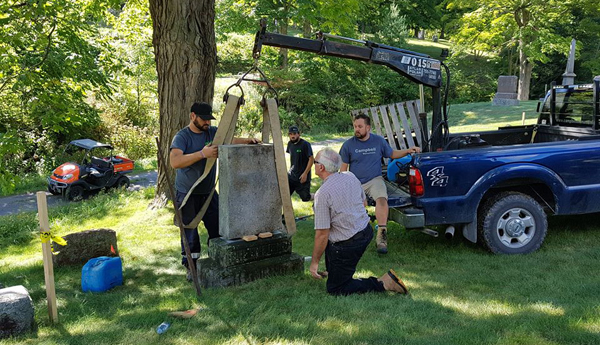
– Glenwood cemetery photo
“Work has now begun,” said Sandy Latchford, Chair of Glenwood Cemetery and vice-president of the historical society. She confirmed Campbell Monument has taken the lead on the restoration project.
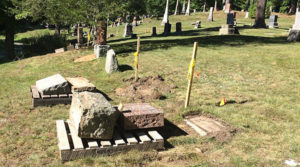
– Glenwood Cemetery photo
“The project of restoration has begun, but it’s going to be this year and next year and maybe a third year,” said Latchford. “We have to do it with great care and caution and ensure we are doing it with the safety of the public and staff in mind, but it has begun and we are very excited about that.”
There were 153 monuments damaged, destroyed or knocked over and 63 foundations that need to be re-done, partly done, attended to, or stabilized before they are put back in place.
Noting the size and weight of the monuments means they cannot just be propped up without careful work to secure bases and foundations.
“These things are not light,” she noted, referencing one ball that was knocked off a monument and rolled down a hill “weighs 600 to 700 pounds”.
Historical Society president Steve Ferguson called the destruction and vandalism incident a “lightning bolt”.
“It made a lot of people reconsider and come to terms with our history and heritage,” said Ferguson. “The violation was not just in a cemetery. This is a heritage property and the outpouring of grief, anger and many emotions as a result of what these individuals did, I think helps those of us who were trying to preserve and protect heritage properties in Prince Edward County, and it has certainly helped inform the public of the importance of this. “We solider on and we will continue to solider on.”
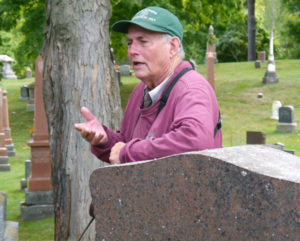
County naturalist Terry Sprague
On a walkabout of the cemetery, Sprague pointed out the unique location of the cemetery, noting how it is made up of drumlins and includes a diverse collection of trees, including gingkos, on the property as well as an amazing variety of birds and wildlife.
Foster spoke to its fascinating history.
“I am really struck by the amount of historic knowledge that is available in cemeteries,” he said. “We drive by them, they are everywhere, yet they capture a unique opportunity in history and capture a moment in time. It’s a truly unique way to capture our history.”
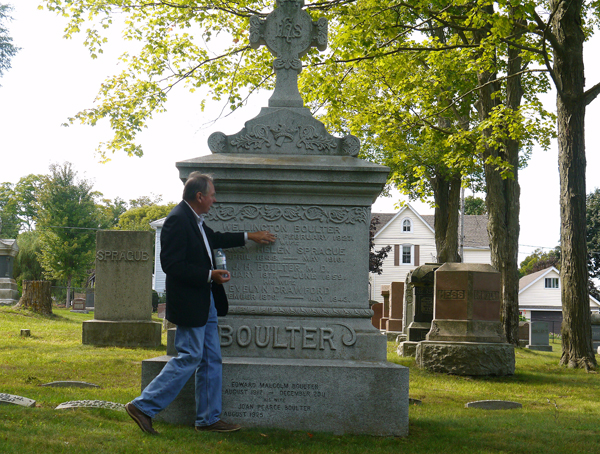
Gary Foster talking about the Wellington Boulter monument.
Cemeteries, he said, offer a sense of what was going on in a community – a time capsule of history, seeing decade-by-decade how transition and change is documented. The earliest monuments in Prince Edward County and Ontario were made of wood, he said, citing two examples of wooden monuments in nearby White Chapel Cemetery dating to 1880 and 1890.
Foster noted the materials used in monuments over time transitioned from wood and limestone to marble and granite. He said most of the white marble tablets used for monuments in this area came via the waterways from Vermont, beginning in the 1840s.
But by 1860, he said marble disappeared from frequent use and was replaced by granite – the reason, he said, was the end of the civil war. The granite monuments came from Scotland via schooner, maybe by train once they reached land, then by horse and buggy to reach the cemetery.
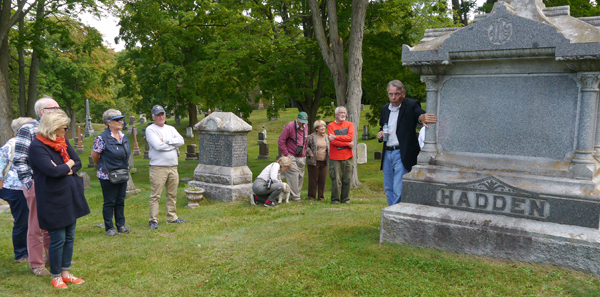
Gary Foster speaking about the Hadden monument
Foster described how economic, political and social history changed monument designs stylistically over time, as trends came and went. Wealth and prestige brought more elaborate monuments and distinct design changes with the addition of spires and obelisks. Some monuments, he said, became massive structures of granite weighing 200 pounds per cubic foot.
“At one time, each person had their own monument and very seldom did you see two names on one monument,” said Foster. “By 1860, people were buried next to neighbours and not with family until the trend changed and that shows up in the cemetery as huge family plots appear. There was a huge spread with the have and have-nots,” he said, noting the more money people made or were born with, the bigger the monument.
The historical society has also been experiencing change over the years with reduced membership, and those on board taking on multiple roles.
“The reason this has been happening is because we work; many of the executive work,” said Ferguson. “We need bodies to help the society flourish and grow. I have at this meeting over the past several years asked for volunteers. If there is anybody who is able to contribute some time and some expertise, you would be most welcome, you really would,” he said.
Plans for the coming year include continued assistance of other events such as the new Fibrefest show and sale in the summer which covers everything ‘from sheep to shawl’.
“Fibrefest was immensely successful,” said Ferguson. “Many of you probably saw the lamp posts in Picton “yarn-bombed” as they call it. Not only did it promote Fibrefest, but knitting was done by the residents of McFarland Home. The knitters had immense pride that they could make a contribution to Main Street.”
“That is a very important part of our history,” said Latchford. “When the earliest settlers came here in the late-1700s, they did not have access to sheep. Fibre has played a very big role in all our cultures.”
“They wanted a fibre event here to bring together crafters and with people working with fibre, people who are raising animals and we thought that was a good idea and we saw the connection,” said Latchford. “We offered to help them with that and support them… They also found out how hard it is to run an event without enough volunteers,” she said.
Latchford, currently holding three positions on the board, was relieved of some duties as a proposed slate of officers for 2018-2019 was nominated. Marc Seguin was nominated as vice-president (currently Latchford), Mary Lazier as secretary (currently Latchford), Fergus Millar as treasurer (currently Latchford), and Lorri Busch offered to take on the vacant role of communications (website and social media). It was proposed Jack and Elinor Hicks remain at the helm of membership.
The board determined that Steve Ferguson would remain in the role of president, at least until municipal election. He noted that if successful in his bid to become mayor, he may have to step down as president. In such case, Latchford would take over as president, but otherwise she will assume the role of director-at-large.
Ferguson again emphasized the need for additional volunteers to come on board. People able to contribute time or expertise are invited to leave a message on Prince Edward Historical Society Facebook page.
Those wishing to financially contribute to the ongoing Glenwood Cemetery restoration project – estimated at a cost of $200,000 – should visit glenwoodcemetery.ca
Filed Under: Arts & Culture • Featured Articles • Local News
About the Author:































